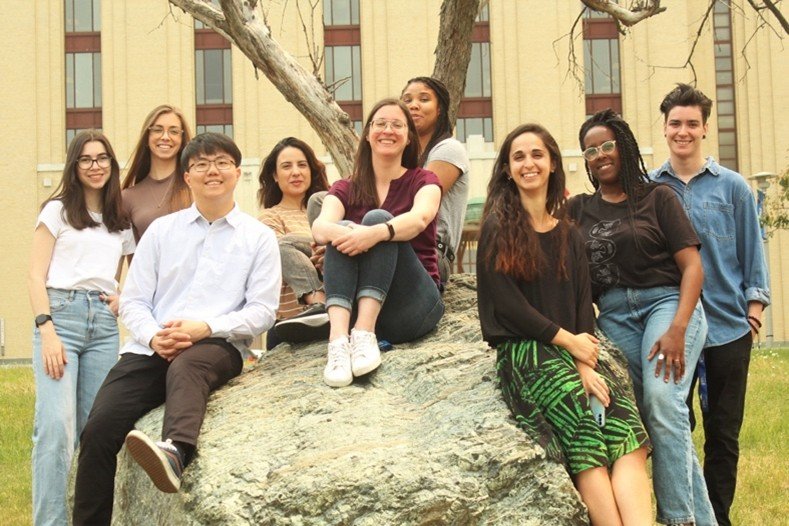Lab Launch
The Drouin-Ouellet Lab is established at the Université de Montréal, Faculty of Pharmacy.
An important scientific question that has yet to be answered is whether PD is the result of accelerated aging, or whether specific age-related cellular processes/pathways are impaired. This is important as the findings would orient our approach for the development of an anti-aging strategy to prevent PD. Our group’s recent success in developing patient-derived neuronal models showing age- and PD-associated changes allows us to be uniquely positioned to address this question. Identifying the root cause of abnormal aging leading to PD will help the selection of the anti-aging therapies that could prevent or halt PD.
PD is associated with a strong astrogliosis, suggesting that triggered astrocytes contribute to the pathophysiology of PD. Astrocytes are also currently being explored as the cell type of choice to convert to neurons to repair the brain of PD patients. Similarly to how we convert skin fibroblasts to neurons, we have established the direct conversion of skin cells to astrocytes, allowing to study the biology of aging in human astrocytes from donors covering the human lifespan, and living with PD. As such, we aim at bettering our understanding of how aging astrocytes contribute to PD, and whether the pathology displayed by this cell-type in the PD brain carries through the neuronal conversion process in the context of direct in vivo reprogramming.
PD is associated with a strong activation of microglia, the resident immune cell of the brain. However, while microglia are strongly suspected to contribute to PD through a pro-inflammatory phenotype, what triggers these microglial changes and what impact these cells have on the disease process remains unclear. Existing patient-derived microglia models are iPSC-based, therefore of embryonic stage. We have developed a new model to chemically induce senescence in human microglia, which generates microglia displaying key hallmarks of cellular aging. We are using this model to investigate age-associated changes in the microglial response using microglia generated from PD patient-derived iPSCs and controls.
Lab Launch
The Drouin-Ouellet Lab is established at the Université de Montréal, Faculty of Pharmacy.
Neural conversion of adult human fibroblasts and mechanisms of direct neuronal reprogramming
Development of a a quantitative model of the governing gene regulatory systems during direct neuronal reprogramming which has provided mechanistic insight into the neuronal conversion process.
Age-related autophagy impairments in neurodegenerative disorders
First study to show pathology in induced neurons derived from idiopathic Parkinson’s disease patients.
A model of chemically induced senescence in microglia
Development of a model of induction of senescence in human microglia and have shown changes in microglial function in senescent cells.
In response to various stressors, cells can enter a state called cellular senescence which is characterized by irreversible cell cycle...
The cause of dopaminergic cell death in the substantia nigra of patients with Parkinson’s disease is unknown”: thus begins the Lancet paper...
We have developed an efficient approach to generate functional induced dopaminergic (DA) neurons from adult human dermal fibroblasts. When performing...
Understanding the pathophysiology of CNS-associated neurological diseases has been hampered by the inaccessibility of patient brain tissue to perform live...
The direct reprogramming of adult skin fibroblasts to neurons is thought to be controlled by a small set of interacting...
Background Although Huntington’s disease (HD) is caused by a single dominant gene, it is clear that there are genetic modifiers...
Using in vitro approached – including high-content imaging, omics, molecular and biochemical assays, – we leverage our expertise in cellular reprogramming, cellular aging and disease modeling to generate patient-derived in vitro models allowing us to study the impact of cellular aging on Parkinson’s Disease pathophysiology.

We generate neurons, astrocytes, and microglia directly from skin fibroblasts and iPSCs of Parkinson’s patients and healthy controls. These models retain age-specific features and provide a human-relevant system to study disease processes.

We specialize in converting human skin cells into functional brain cells without passing through a stem cell stage. This preserves age-related signatures and enables modeling of late-onset diseases in vitro.

We use transcriptomics, proteomics, and pathway enrichment analyses to identify molecular signatures of aging and disease. These approaches reveal key differences between healthy and PD-derived brain cells.

We use RNA sequencing and proteomics to uncover gene expression and protein-level changes associated with aging and Parkinson’s Disease in patient-derived brain cells.

From oxidative stress markers to mitochondrial function, we apply a broad array of molecular tools to quantify biological changes that contribute to PD pathophysiology.
Our lab brings together passionate scientists from diverse backgrounds who are committed to advancing our understanding of aging and neurodegeneration. We collaborate across disciplines to push boundaries in reprogramming technologies, disease modeling, and neuroinflammation research.
